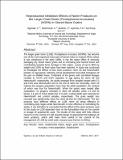Reproduction Inhibition Effects of Neem Products on the Larger Grain Borer (Prostephanus truncatus) (HORN) in Stored Maize Grains

View/
Publication Date
2012-12-07Author
V Ogemah, C Reichmuth, C Buttner, PO Ayiecho, NCO Keya
Metadata
Show full item recordAbstract/
The larger grain borer (LGB), Prostephanus truncatus (HORN), has become one of the most important insect pest of stored maize in tropical Africa where it was introduced in the early 1980s. It has the major effect of seriously damaging dry stored maize grains and so increasing post-harvest losses and contributing towards food shortage in this region. Losses of up to 85% by weight and 100% by food value have been reported. A study was conducted to investigate the effects of two neem products, neem oil and NeemAzal® powder on egg laying, hatching, larval development and adult emergence of the pest on shelled maize. Treatment of the grains with sub-lethal dosages resulted in 76.3% and 0.6% reduction in egg laying by neem oil and NeemAzal®, respectively. No adults emerged from samples treated with 0.3 and 0.6% w/w NeemAzal® and ca 2% v/w of neem oil. Generally, neem oil reduced the progeny population more than the adult population, the contrast of which was true for NeemAzal®. When the grains were treated after
oviposition, no progeny emerged in neem oil samples while 4.4 and 20
larvae, 3.4 and 27.8 live adults and 17.6 and 1.4 dead adults were observed in NeemAzal® and control samples, respectively. The grain weight loss recorded was significantly lower for neem oil than for NeemAzal®. The two products have different effects on LGB, neem oil being effective in controlling early stages while NeemAzal® is more effective in controlling the adults. It can therefore be concluded that the effect of the neem products used in this study on LGB depended more on the formulation than on the content or dosage of azadirachtin used. The results of this study will help refocus research on the control of LGB towards design of appropriate formulations of neem products, which will make them useful in the control of the management of LGB by small scale, resource poor farmers in Africa.
Collections
- Department of Botany [232]
